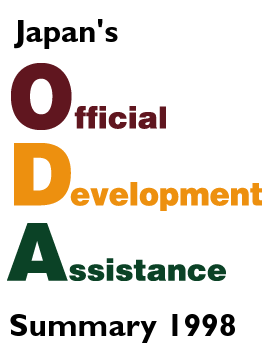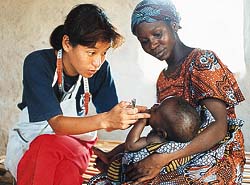Official Development Assistance (ODA)
Japan's ODA Annual Report (Summary) 1998


Why is ODA necessary?
International peace and prosperity are essential for any country as dependent as Japan has become on foreign markets and resources. Official development assistance (ODA) helps foster that peace and prosperity in a world that is growing ever more interdependent.
As a peace-loving nation, Japan has a mission to assume a role commensurate with its economic capability to help sustain world peace and work in the interest of international prosperity. Half a century ago, immediately after the last world war, Japan lay almost in ruins. And lest anyone forget, it should be pointed out that foreign aid helped Japan rebuild and lay the foundations for the prosperity it enjoys today. The Fourth Kurobe Dam and the Tomei and Meishin Expressways stand out as leading examples of infrastructure projects that were funded by loans from the World Bank.
Guided by the above perspective, Japan has chosen to provide official development assistance in keeping with several fundamental viewpoints, as follows.
- Many people in the developing world today still suffer from conditions of malnutrition and extreme poverty. From a humanitarian vantage point, the international community cannot ignore their plight.
- Environmental problems, population pressures, and food shortages count as challenges for all humankind. It accordingly seems imperative that the industrialized and developing worlds work together to address them. Moreover, as a major industrial power, Japan should assume a leadership role in that drive.
- Providing aid to the developing world and working on global issues can be expected to earn Japan better ties with other countries, particularly in the developing world, bolster its stature in the eyes of the international community, and contribute to broader global understanding of and support for Japan and its people.
- In a world that has been brought closer together by trends in trade and investment, and as a country heavily dependent on the rest of the world--and particularly many developing countries--for its own supplies of resources, energy, and food, Japan stands to gain in economic terms by utilizing aid to promote economic progress throughout the developing world.
Contents
- Official Development Assistance (ODA): Its Significance and Recent Trends
- The 1997 Aid Track Record
- ODA and the Asian Currency and Financial Crisis
- Health Care (1): Primary Health Care and the Future Shape of Health-Care Assistance
- Health Care (2): Efforts to Deal with Specific Diseases and Other Health-Care Challenges
- Assistance to Economies in Transition
- Regional Conflicts and the Role of ODA
- Efforts in Environmental Conservation
- Other Global Issues
- The Second Tokyo International Conference on African Development
- The New Development Strategy
- The ODA Charter
- Public Understanding
- Participatory Development: Assistance for NGO Activities
- Efforts to Provide More Efficient and Effective Aid
- Terms and Conditions for Yen Loans
Reference
- General Account Budget for ODA (all government agencies)
- ODA Operating Budget (all government agencies)
- Major Recipients of Japan's Bilateral Assistance by Aid Scheme (1997)
- List of Countries to which Japan is the Top Donor
- Japan's Official Development Assistance Charter
- History of Japan's Assistance to Developing Countries (1945-1998)
Charts
- Chart 1: Trends in Major DAC Countries' ODA (Net Disbursement Basis)
- Chart 2: Trend of Japan's ODA/GNP Ratio
- Chart 3: ODA/GNP Ratios of DAC Member Countries (1997)
- Chart 4: Bilateral ODA in the Public Health and Medical Services Sector
- Chart 5: Disbursements of Japanese Aid in the Environmental Field
- Chart 6: Location of Plaza for International Cooperation
- Chart 7: Collaboration between the Ministry of Foreign Affairs and Local Governments
- Chart 8: Amount of Money Disbursed Per Person Engaged in ODA (Government Implementing Agencies Included)
- Chart 9: Trends in Procurement Conditions on Japan's ODA Loans
- Chart 10: Trends in ODA Loan-Funded Corporate Contracts (By Country, Local Currency Costs Excluded)
- Chart 11: Trends in Corporate Japanese Bids Tendered and Won for Projects Worth 1 Billion Yen or More
Topics
- The Asian Economic Crisis and Assistance to Scholarship Programs
- A Health Center for Island Population: The Tamara Health Center Project
- Peace Brings Improvements in Water Lifeline
- Beyond Survival - The Challenge of Micro-credit (PR Video)
- Japanese Aid Can Be a Fountain of Progress: Letter from a Senegalese Village Chief
- An Internet Source for ODA-related Information: the MoFA Web Site
- A Joint Effort by Japanese and U.S. NGOs and the Japanese Government: Providing Used Bicycles to Teachers in Ghana
- The Papua New Guinea Tidal Wave Disaster: Dispatch of a Japan Disaster Relief Team
